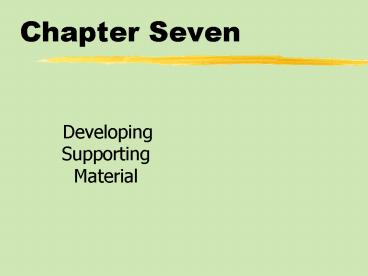Chapter Seven - PowerPoint PPT Presentation
1 / 20
Title: Chapter Seven
1
Chapter Seven
- Developing Supporting
Material
2
Chapter Seven
- Table of Contents
- Types of Supporting Material
- Locating Supporting Material
- Organizing and Documenting Source Material
- Critically Evaluating Sources
3
Types of Supporting Material
- Examples
- Narratives
- Testimony
- Facts and Statistics
4
Types of Supporting MaterialExamples
- Illustrations, descriptions, or representations
- brief example- a single illustration of a
speakers point. - extended example- multifaceted illustration of an
idea, item, or event being described. - hypothetical example- illustration of a point
made by describing something that could happen in
the future.
5
Types of Supporting MaterialNarratives
- Stories, both real and imaginative.
- Forms
- fairy tales
- legends
- religious narratives
- myths
6
Types of Supporting MaterialNarratives
- Essential storytelling elements
- plot
- characters
- setting
- timeline
- Anecdote
- short story of an interesting, humorous, or
real-life incident.
7
Types of Supporting MaterialTestimony
- Firsthand findings, eyewitness accounts, and
opinions that directly support a fact or an
assertion. - expert testimony- by professionals who have been
trained to evaluate or report on a given topic. - lay testimony- by non-experts who have witnessed
or experienced events related to the subject
under consideration.
8
Types of Supporting MaterialTestimony
- Credibility is key
- The speaker must establish credibility
- establish the reputation of the source.
- cite the sources name, title, and relevance to
the topic.
9
Types of Supporting MaterialFacts and Statistics
- Facts- documented occurrences that include
events, dates, times, people, and places. - Statistics- data expressed in numerical form.
- descriptive statistics- data or information that
characterize a group or classification. - inferential statistics- data collected from a
sample or representative group and generalized to
a larger population.
10
Locating Supporting Material
- Getting Started
- Primary Research Interviews and Surveys
- Secondary Resources Print, Electronically Stored
and Online Sources
11
Locating Supporting Material
- primary research- original or firsthand research
conducted by the speaker. - secondary research- the vast body of information
gathered by others.
12
Locating Supporting MaterialGetting Started
- Focus on the purpose of your speech.
- Develop a thesis statement.
- Evaluate resources.
- Decide on research methods.
13
Locating Supporting MaterialPrimary Research
Interviews and Surveys
- Interviews
- planning the questions
- phrasing the questions
- recording the interview
- conducting the interview
- Surveys
- especially useful for topics related to the
attitudes, values, and beliefs of people in your
immediate environment.
14
Locating Supporting MaterialSecondary Resources
- Database- a base or place in which information
is stored, such as books or computers.
15
Locating Supporting MaterialSecondary Resources
- Reference Desk
- Card or Online Catalog
- Books
- Newspapers
- Periodicals
- Encyclopedias
- Books of Quotations
- Poetry Collections
- Atlases
- Almanacs
- Government Publications
- Biographical Resources
16
Organizing and DocumentingSource Material
- Bibliography
- APA Method
- MLA Method
- Chicago Style Method
17
Organizing and DocumentingSource Material
- Elements
- names of authors/editors
- title of publication
- volume or edition number
- name of publisher
- place of publication
- publication date and year
- page numbers
18
Critically Evaluating Sources
- Strive to use original sources
- Developing Conclusions
- Beware of Errors in Data Interpretation
19
Critically Evaluating SourcesDeveloping
Conclusions
- Acknowledge viewpoints when they are relevant.
- Include sufficient quantity and quality of
evidence to substantiate your claim.
20
Critically Evaluating SourcesDeveloping
Conclusions
- Does the supporting material actually say what
you think it says?































